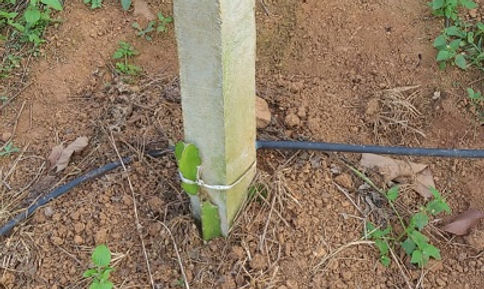
Dragon Fruit Farming
How to propogate Dragon Fruit plants
-
Dragon fruit or Pitaya grows well in warm-winter climates
-
They can be propagated from seeds and also from stem cuttings but the best way to propagate is from stem cuttings. Propagating from seeds to fruit production make take seven years
-
To propagate stem cuttings, obtain a 6 to 15 inch stem segment. After that, dip the cutting into a root hormone and then plant directly in the garden or in a well-draining soil in a container.
-
Water the cuttings thoroughly to allow the soil to settle
-
It may take a few weeks for them to begin generating roots and you start to see new top growth as well.
-
Once these develop roots, we’ll transplant them to larger pots closer to concrete pillar or post for support
Irrigation for Dragon Fruit plants
-
Dragon fruit plants require less water compared to other plants.
-
Under normal conditions, Dragon Fruit plants should be watered about once every two weeks
-
However during flowering, fruit development and hot dry climatic conditions, frequent irrigation are required
-
Drip irrigation can be used for effective irrigation method
Support Methods for Dragon Fruit
-
Once your dragon fruit plant reaches 1 to 2 feet tall, it will need a support system to continue growing
-
Take a concrete pillars or another post of height 6 feet and bury the pillar / post at a depth of 1 feet
-
If you use to post of more height the plants will grow higher and the fruiting time will get delayed
-
The concrete pillars should supported by a square structure in the top to train the vine for bearing purpose.
Pest control for Dragon Fruit plants
-
Watch for pests and diseases.
-
Common pests include aphids, mealybugs, and ants.
-
Use organic insecticides or natural predators to control them.
-
Fungal diseases can occur if the plant stays wet for too long.
-
Avoid overhead watering and remove infected parts immediately
Flowering of Dragon Fruit plants
-
Dragon fruit plant will produce flowers during March to October.
-
Bud Formation (Days 1–15). Small green buds emerge from the plant’s areoles.
-
Bud Elongation (Days 16–20). Buds grow rapidly to 10–15 cm.
-
Bloom Preparation (Days 26–27) Bud swells and emits a strong fragrance.
-
Flowering (Night of Day 27). Flowers bloom at sunset and are fully open by midnight. They close and wilt by mid-morning unless pollinated.
-
Proper care during these stages ensures healthy blooms and maximizes fruit yield.
Tips for Maximizing Yield and Quality
-
To get the best yield, maintain consistent care.
-
Water regularly and fertilize with organic compost or manure.
-
Avoid chemical fertilizers to support organic farming goals.
-
Prune the plants to remove old and weak stems.
-
This encourages new growth and more flowers.
-
Remove any damaged or diseased parts immediately.
-
Ensure good pollination by hand pollinating flowers if needed. This increases fruit set and size.
Harvesting Dragon Fruits
-
Generally 27–35 days after flowering is ideal for harvest.
-
Exact timing depends on the variety and climate: White-fleshed varieties: ~27–30 days; Red-fleshed varieties: ~30–35 days
-
Dragon fruit is ready for harvesting when the color changes from bright green color to red color
-
Harvesting too early leads to bland taste and poor color.
-
Early morning or late afternoon is best timing for harvesting
-
You want to grab the dragon fruit firmly in your hand and gently twist it until it breaks free from the plant.
-
Remove field heat by placing fruits in a cool, shaded area after picking










